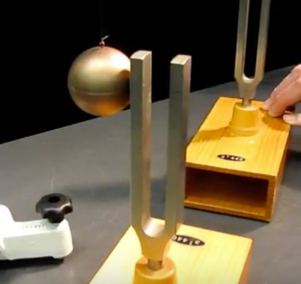Tuning Fork Resonance + Ping Pong Ball
Description: In this video the vibration of one tuning forks is transferred through sound to another tuning fork. The ping pong balls bounces in response to this vibration. This can be used as an anchoring phenomenon in a grade 1 class but also can be used as supporting phenomenon in grades 4 and up.
Web Resources: Tuning Fork Resonance on YouTube - Flinn Scientific Tuning Fork Demonstrations
Rubens' Tube
Description: The Rubens' tube was invented by German physicist Heinrich Rubens in 1905. It is a tube that is sealed at both ends in includes a flammable gas like propane. A speaker is attached to one end of the tube so sound waves can be transmitted thought the air/gas mixture. Small holes are drilled in the top of the tube and when the air/gas mixture emerges it creates a flame. As sound is played standing waves are created in the flames that change as the frequency of the waves is changed.
Web Resource: Rubens’ tube - Wikipedia
The Visual Microphone: Passive Recovery Of Sound From Video
Description: In this amazing demonstration researchers are able to extract audio from the video of an object (a plant, an empty bag, etc.) in the same room as the sound. The sound waves vibrate the object which is made visible through tiny movements processed with a graphic algorithm. This could be used as a phenomenon in a unit on sounds, waves, and information.
Web Resource: Extracting audio from visual information - MIT News
Daniel Kish Uses Echolocation To Navigate
Description: Daniel Kish lost his eyes to cancer before he was 13 months old. He uses echolocation by listening to the reflection of sound waves to navigate in 3D space. He can even ride a bicycle. In addition to being an incredible story of perseverance this is a perfect phenomenon for a unit on waves. Sound waves are reflected, absorbed, and transmitted through objects in the environment and Daniel can sense the changes in energy of the returning waves.
Web Resource: Daniel Kish - Wikipedia
Shatter A Wine Glass With Your Voice
Description: You can shatter a wine glass with your voice but it isn't easy. The pitch must match the natural frequency of the glass and the volume must be high enough t0 physically vibrate the glass. The video below documents how long it takes Mike Boyd to achieve this task. Most students understand that vibrating materials create sound but they don't realize that the opposite is true as well.
CAUTION: When the glass breaks tiny shards of glass can enter your eye and so eye protection should always been warn when attempting this phenomenon.
Web Resource: Fact or Fiction?: An Opera Singer's Piercing Voice Can Shatter Glass - Scientific American
There Is No Sound In Space
Description: A famous physics phenomenon is included in the video below. A bell ringing in a bell jar will become quiet when the air is removed from the bell jar. Since sound is caused by vibrating material and all of the material has been removed from the bell jar there is no sound. This means that there is no sound in space. Recent discoveries from NASA has shown that there may be sound in space (due to oscillating interstellar gases) but it is not a sound humans can perceive on their own.
Web Resources: Bell in a Bell Jar, There Actually Is Sound in Outer Space - Gizmodo
Tin Can Telelphone
Description: The tin can telephone is made of a string connecting two tin cans or paper cups. When the sender talks into one side it vibrates air in the cup which vibrates the bottom of the cup. This vibration is transferred through the string and received at the other end by sound. This phenomenon can be used to address sound as vibrating materials and can be used as an example of a communication device.
Web Resource: Talk through a String Telephone
By This is from Project Runeberg book called The key to science In swedish., Public Domain, Link
By Robert Benson [CC0], from Wikimedia Commons








